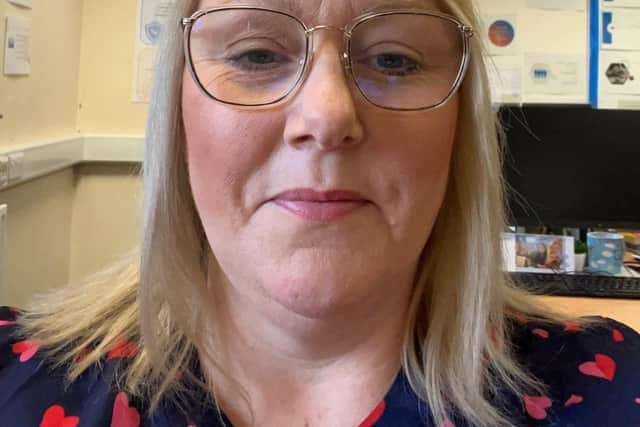Virtual wards are 'the future' as Wigan hospital patients benefit from staying at home
and live on Freeview channel 276
Respiratory consultant Dr Abdul Ashish has treated many patients on the wards over the years – but now he is involved in caring for them in a new way.
For Wrightington, Wigan and Leigh Teaching Hospitals NHS Foundation Trust (WWL) has been leading the way in running virtual wards.


Advertisement
Hide AdAdvertisement
Hide AdThis sees patients staying at home – rather than being admitted to a hospital bed – but being closely monitored by medical staff using new technology.
WWL was among the first trusts to treat patients this way and it has proved to be so successful that it is being rolled out across the country.
As the initiative is scaled up, it is seen as a key way of easing pressure on in-demand hospitals and their staff.
Dr Ashish said: “Hospitals cannot always expand, we cannot recruit doctors and nurses all the time.


Advertisement
Hide AdAdvertisement
Hide Ad"This is a much more efficient, safe and digitally enabled solution to the current healthcare crisis.”
It is not just the NHS that benefits from the virtual wards freeing up hospital beds, as patients benefit from being at home.
Dr Ashish said: “It gives them that reassurance that someone is looking after them. Largely what we have seen is patients feel reassured, patients feel that they have the benefit of professionals looking after them all the time and the support from the local hospital and the local teams.”
WWL’s bosses started talking about virtual wards in September 2021, after hearing about a pilot project in Norfolk.


Advertisement
Hide AdAdvertisement
Hide AdSome patients were supported at home during the pandemic, using basic pulse oximetry equipment, but this would involve specialist equipment and staff.
With limited space to expand on the Wigan Infirmary site for more beds and rising numbers of patients, virtual wards were seen as a good idea.
It officially opened in January 2022 with respiratory patients, but has since expanded to manage people with a range of conditions, including heart failure, diabetes, coronavirus, blood pressure issues and frailty.
Virtual wards can be a “step down” from hospital care, when patients have not fully recovered but do not need the same level of support, but can also be a “step up” offering care at home rather than admitting them to hospital.
Advertisement
Hide AdAdvertisement
Hide AdThe patients are given equipment which monitors their vital signs – blood pressure, pulse, heart rate and skin temperature – along with a tablet computer for video conferences with nurses and doctors.
Alison Chadwick, clinical quality lead (virtual care) in WWL’s community division, said: “The kit is really quite unique. The patient is fitted with the kit in hospital and they are stepping down to care at home. Our team goes to the ward to fit them with the kit and teach them how to use it.
"It’s essentially a little elastic band that goes round the top of the arm, a bit like a watch. There’s a small disc that needs to be in contact with the skin and it’s able to record all those measurements. It does that every 15 minutes for 24 hours.”
Patients are also given equipment to take their blood pressure four times each day and taught how to use the tablet to speak to medical staff.
Advertisement
Hide AdAdvertisement
Hide AdWhile it is simple to use, some people may have problems especially older people unfamiliar with technology, but staff can visit them at home to make sure they know what to do.
A team of medical staff at a hub and at Wigan Infirmary monitor the information from the equipment and are available to speak to patients between 8am and 8pm every day.
They can sometimes spot a problem before a patient is even aware of it, thanks to the data.
Arrangements can be made if they need further tests or treatment in hospital and if they need to be admitted, the patient does not need to go through the A&E department.
Advertisement
Hide AdAdvertisement
Hide AdThere are many benefits to the virtual wards, including patients being able to rest and recuperate in the comfort of their homes rather than the unfamiliar, busy hospital wards.
Elderly patients can become more frail when admitted to hospital as they are not moving around, but this is overcome at home as they will get up to make a drink, for example.
The risk of cross-infection in a hospital is also eliminated.
People in hospital can be discharged sooner thanks to the virtual wards, freeing up beds for other patients, and they still get the support they need.
Advertisement
Hide AdAdvertisement
Hide AdThe average stay on the virtual ward used to be nine days, but consultants now review patients daily, rather than three times a week, and the length of stays has reduced.
Over the past year, 1,324 patients have been cared for on a virtual ward, saving 4,920 hospital bed days.
Dr Ashish said: “Less than five per cent of patients have to return to hospital. I think the majority of patients – 95 per cent – leave the service and would recommend it to other users.”
They have been particularly popular among people with ongoing health issues, who request to stay on a virtual ward rather than being repeatedly admitted to hospital.
Advertisement
Hide AdAdvertisement
Hide AdThere are currently 45 beds on the virtual ward, with staff being recruited to extend this to 60 and an aim to increase this to 150 over the coming year. It is hoped it will then make a real difference.
Dr Ashish said: “If we were to see a reduction in the impact on patients coming to Wigan hospital, we need to scale it up. We need close to 100 or 150 virtual beds to be able to see an impact.
"I think the biggest impact will be when ambulance services and GPs are able to directly refer in as the first port of call, so patients have an alternative rather than turning up to A&E.”
